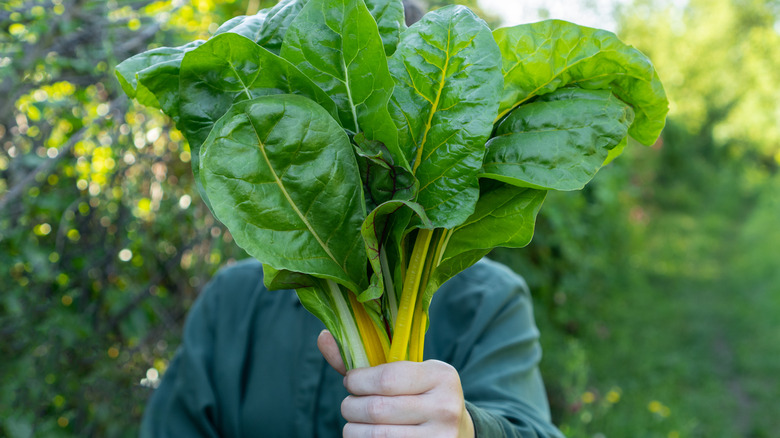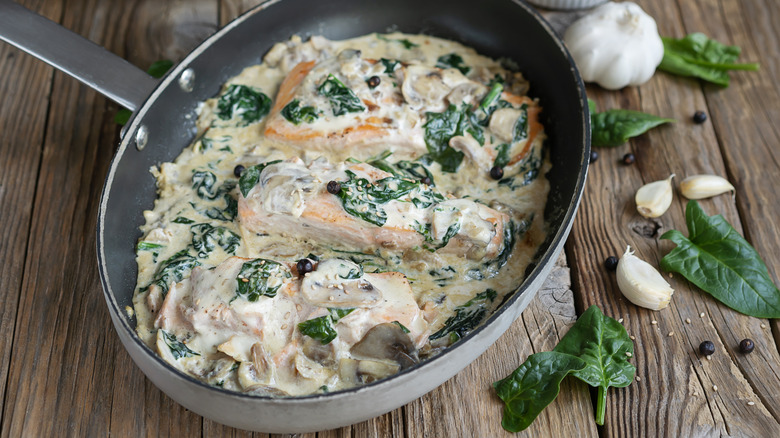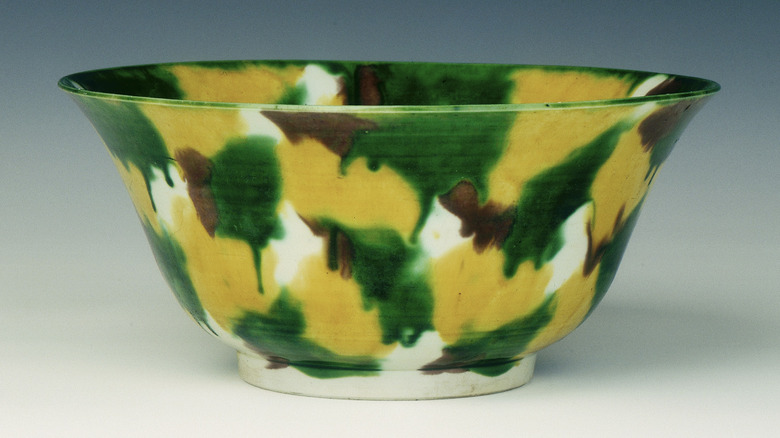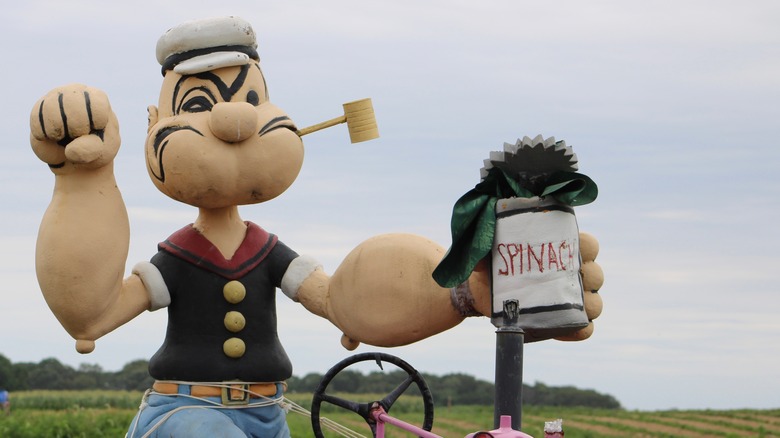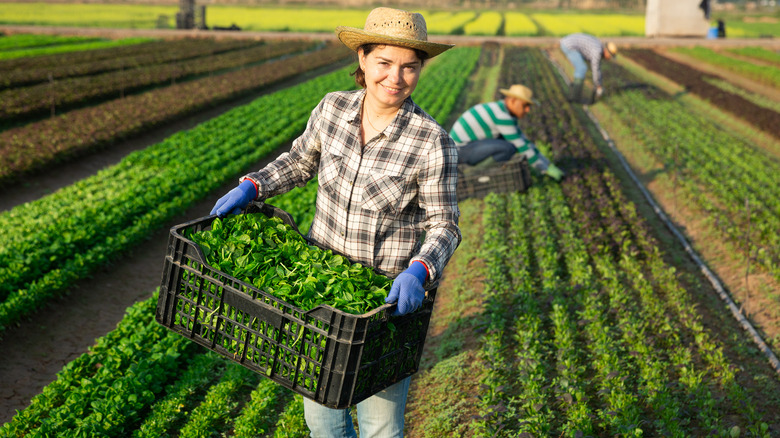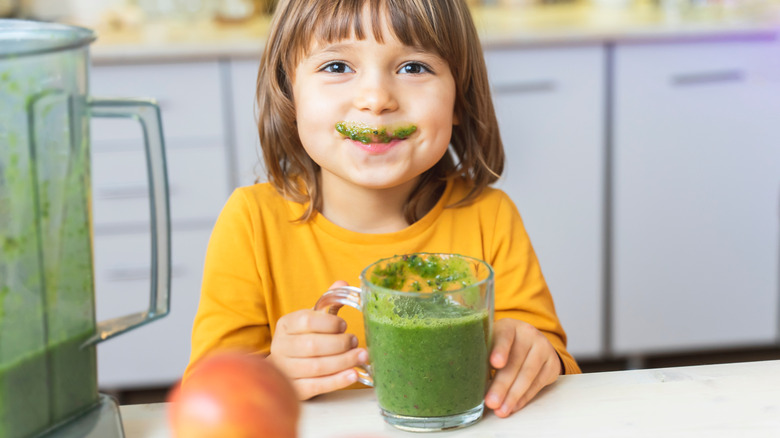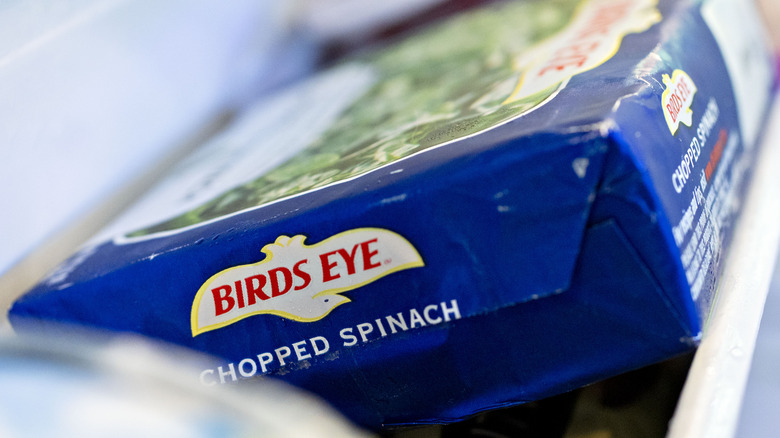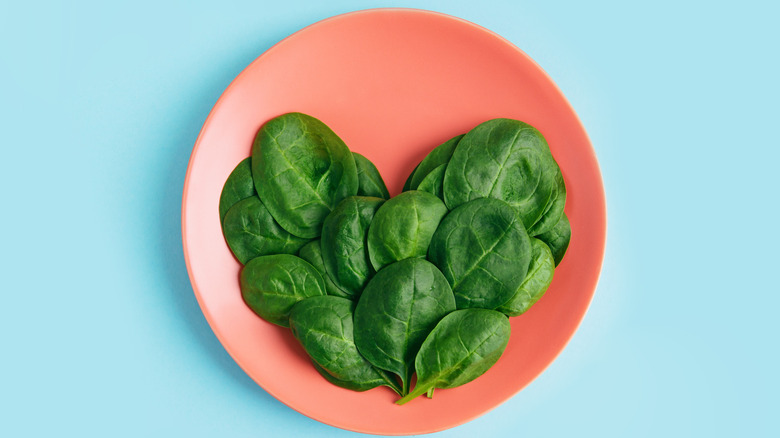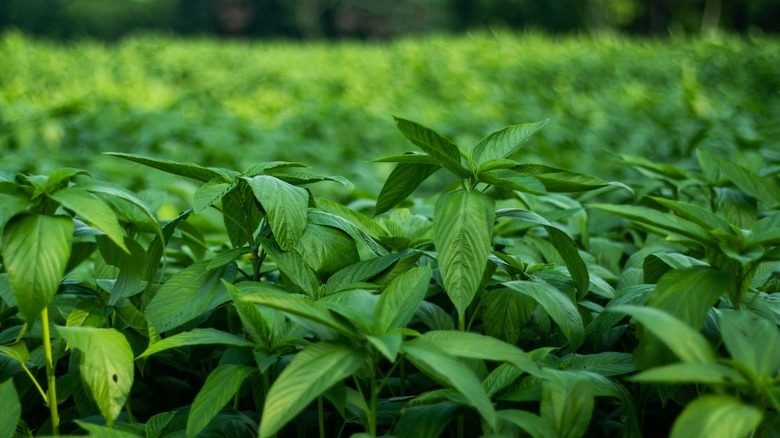The Untold Truth Of Spinach
During the 19th century, spinach rose in popularity in the United States. However, the history of spinach goes back thousands of years to ancient Persia. Spinach has been called the prince of vegetables and its name in English derives from the Persian word for green hand. The King of Nepal gifted spinach to China in the 1600s, and the Moors came to Spain with spinach a few hundred years later (via Food Literacy Center). There are three main varieties of spinach, including the flat type which is canned or frozen, as well as sold fresh. There's also savoy spinach, which has crinkly leaves, and semi-savoy spinach with leaves that are not quite as crinkly (per UGAOO). While spinach may look like chard, it is quite different.
March 26 is National Spinach Day and with spinach such an incredibly tasty, versatile, and brilliantly colored vegetable that has a rich history and even richer nutrients, there's a lot to celebrate about this green, leafy plant. The untold truth of spinach reveals not only why this culinary favorite is more popular than ever before, but also how it could hold the key to creating a more sustainable future by helping produce power and energy too! It's not surprising that Popeye loved his spinach so much, and so does the rest of the U.S.
Spinach was popular in Medieval Europe and England
Known as the Spanish vegetable, spinach was being cultivated in Spain from the 11th century. According to Mediterranean food writer and cook Clifford A. Wright, spinach was able to grow successfully, despite preferring cooler weather than the hot sun in Spain, due to the highly developed irrigation methods and horticultural know-how of the Arab agronomists. Throughout the years, France and Italy popularized spinach, and Mediterranean Jews included spinach in many of their recipes. With Spain being so enamored with spinach, it was only a matter of time before it traveled to other countries nearby.
In the Middle Ages, spinach really became popular in Europe and beyond. Included in a collection of recipes for the well-to-do and royalty in Europe in the 13th century, spinach was primarily eaten by wealthier households during that time period in Germany. Later, spinach became popular in soups and more down-to-earth dishes, too.
Spinach also features in English medieval cookbooks. According to Gode Cookery, two 15th century cookbooks in England offered recipes for buttered wortes, with renowned English poet Geoffrey Chaucer also mentioning wortes in his great work, The Canterbury Tales. Wortes, during this time, included spinach, as well as other greens and herbs.
In 16th century Italy, spinach was a favorite vegetable on the dinner plates of upmarket households, per Medieval Histories.
Some spinach dishes are named in honor of a queen
After becoming queen of France in the 16th century, it's rumored that Catherine de Medici brought spinach to the French from Italy when she married Henry II. Such was her love for the healthy green vegetable that the queen apparently ate spinach with every meal. As a result, dishes made with spinach were named Florentine, after her birthplace of Florence (per National Geographic). Whether she popularized spinach in the French court or not, the recipes in her honor do.
Florentine dishes are often made with a mornay sauce, which is a bechamel sauce with Gruyere cheese added, and is often served with fish, white meat, or eggs. Recipes in this style include a version of eggs benedict, eggs a la Florentine, with a poached egg on a bed of spinach and either a classic hollandaise or a mornay sauce on top. The French queen certainly seemed to love her food etiquette as much as her food, as she's also recognized in a collection at The Metropolitan Museum of Art, or The Met as it's more commonly known, as being the person who introduced the fork to France too. During her reign in France, she also brought ice cream to the country, after she received the recipe from one of her Italian chefs, who came up with the idea during a competition she organized for unusual dishes (via Florence Inferno).
Spinach was used as green ink pigment
With its vibrant green leaves, the beautifully rich color of spinach is caused by various pigments in the plant. According to Sciencing, spinach contains a blue-green chlorophyll and a green-yellow chlorophyll, along with carotenoids which add red, yellow, and orange and aid photosynthesis, and result in the dazzling dark emerald hues of spinach. In medieval times, this strong color was used to create a non-toxic pigment, which artists used on manuscripts (via Global Networks).
Gardening Know How outlines a great way to make natural dye using spinach. Spinach isn't the only food product to be used as a coloring, as eggs have also been used to bind ingredients as well. To make your own dye, chop up a cup full of spinach leaves (240 mL), add double the amount of hot water, and blend before straining the concoction and adding a tablespoon of salt. If you don't have a blender, then simmer the spinach and water in a pan for one hour, after you've first brought it to a boil, and then cool and strain.
According to Gardening Know How, you can use your dye to color fabrics by first boiling the fabric in water with one cup vinegar to four cups of water. Keep this bubbling for an hour to create a fix so your dye is long-lasting, and then rinse in cold water. Next, soak the fabric in the spinach dye until you have the perfect shade of green.
The super-myth about spinach being a good source of iron
An Internet Journal of Criminology paper by Dr. Mike Sutton debunks a popularly held belief that spinach is full of iron. In fact, even the popular story about a German scientist making a simple scientific error about the iron content of spinach in 1870 was itself something of a myth. However, this narrative was highlighted in 1972 by Professor Arnold Bender and popularized after it was described in 1981 in the British Medical Journal by Professor Terence Hamblin. The professors referred to a story about how the scientist, when researching the iron content of spinach had put the decimal point in the wrong place, suggesting spinach had ten times more iron in it than it does (via New Scientist).
Spinach has about the same amount of iron as other vegetables, and actually contains an iron blocker. Oxalic acid hinders the nutritional absorption of iron, according to Nutritics. That's not to say that spinach isn't super good for you, just that the image of the famous animated character Popeye the sailorman bursting open tins of spinach to give him strength actually has nothing to do with the vegetable being a good source of iron.
So how come spinach was Popeye's favorite food?
Do you know why Popeye loved his spinach so much? Or at least, why did the creatives behind this beloved cartoon character have him chow down on spinach to boost his super-strength abilities and get his muscles popping? It's certainly true that spinach production did rise by a third in the 1930s, but this had nothing to do with iron.
According to FiveThirtyEight, criminologist Mike Sutton scanned comic strips and found that the animated sailor, who was constantly trying to woo Olive Oyl with his show of strength, first ate spinach in 1931. In 1932, Popeye explained why he ate spinach in his own distinct dialect, "Spinach is full of vitamin 'A', an' tha's what makes hoomans strong an' helty."
Amid all the myths about myths, this much is true, spinach is a good source of Vitamin A. While Popeye's amazing feats of super-strength may have inspired spinach consumption in 1936, there were signs that it was already becoming more popular. A HealthWatch article suggests that President Roosevelt's New Deal for Farmers which encouraged non-eroding crops such as spinach to be grown may have been one of the reasons for the rise of spinach in the U.S., as well as other changes in agricultural laws which limited certain crops and may have boosted greater diversity, including more spinach. However, there's no doubt that the idea of spinach being good for you was put in the minds of many by Popeye too.
Arkansas is home to the Spinach Capital of the World
In the 1980s, the home of the Allen Canning Company, Alma, in Arkansas, which was responsible for most of the canned spinach in the U.S. declared itself the Spinach Capital of the World, according to Arkansas Road Stories. However, Crystal Springs in Texas also considered itself to be the holder of this title, being the location of the Del Monte cannery, not to mention boasting a statue of spinach-loving cartoon character Popeye in the center of town. Before long, the friendly rivalry led to Alma installing an eight-foot-high Popeye made out of papier mache which, after being stolen twice, was replaced by a heavier model.
Perhaps to secure the accolade of being the Spinach Capital of the World, Alma's water tower was also painted green in the early 1990s to resemble a green can of spinach, with a painting of Popeye on the front. Meanwhile, just in case any motorists passing by or visitors were in any doubt, the artwork also declares that this is the "World's Largest Spinach Can". It's certainly true that Arkansas has produced a lot of spinach, as in 1978, the Popeye spinach brand was acquired by the Allen Canning Company.
Spinach is a superfood
While spinach may not be the great iron provider it was once thought to be, there's no doubt that spinach is a superfood and it's pretty darn good for you. It's great to eat raw, cooked or even in a smoothie, as well as added to many different dishes. Perhaps try a warm spinach salad or a green smoothie blending the dark green spinach leaves with yogurt.
The vitamins and minerals in spinach are also touted as being great for the skin and hair, as well as for the eyes and cardiovascular health (via Medical News Today).
The Food Literacy Center calls spinach the "green wonder", because it's packed with nutrients that are great for your bones and your heart, such as magnesium and potassium, plus vitamin K which benefits blood vessel health. Spinach is also high in calcium and is a good source of manganese, vitamin B6, and folate. When you eat your spinach, you're also ingesting vitamins C, E, A, and B2, while there's also iron, copper, and zinc in there too. The splendid powers of spinach as a superfood include anti-inflammatory properties, as well as being an antioxidant.
The first ever frozen vegetable on sale was spinach
Thyme Machine Cuisine highlights the fascinating history of spinach as the first vegetable to be frozen commercially by Birds Eye, an American international frozen food company set up in 1923, using founder Clarence Frank Birdseye's new quick-freezing technology. It was in 1930 that the Davidson's Market grocery store in Massachusetts became the testing ground for the first frozen Birds Eye product, spinach, with Birdseye patenting his techniques and branching out to more stores, with more products.
Underwood Gardens highlights how the Spinach season runs from March to May and then from September to November. The suggestion is that because the spinach season is relatively short, this could be one of the reasons why it was chosen as the first to be frozen. Certainly, Birdseye was a fisherman at heart, working with the head of the US Fisheries Association, as explained in a feature on the frozen-food innovator in Wired and his focus was on getting food such as fish to consumers without it going bad, thus improving the lot of those who worked in the industry
Nowadays, there are plenty of recipes using frozen spinach from pies to pasties. Because there's more water in the frozen rather than the fresh variety, it's important to know how to dry wet spinach out properly too, if need be. For example, you may opt to squeeze the water out of spinach using a sushi mat (via Fine Cooking).
The world loves spinach
Globally, the consumption of spinach in 2020 was 32 million tons, as highlighted in Vegetarian Times. Spinach imports into the U.S were higher than the previous year by 20%. It shows that during a time of crisis at the height of the COVID-19 pandemic, people were still eating their greens, and perhaps trying to boost their immune systems during uncertain times. The U.S. loves spinach so much that they have to get the good green stuff from outside the country as they can't produce enough to meet demand.
With the worldwide spinach market worth around $39.6 billion in 2020, China is the biggest consumer, producing nearly all of their spinach domestically. The U.S. is the biggest importer, and according to an IndexBox report, the main drive behind this spinach trend is down to more people wanting "nutritious foods". The report forecasts that this quest for healthier produce will push forward the organic spinach market, while consumption is expected to rise to 42 million tons by 2030.
How spinach could save the planet
Research is being carried out at the American University in Washington, D.C. on how spinach could be converted into a natural catalyst for batteries. It means spinach could create enough energy to power cars in the future, going one step further than providing nutrients and fuel for the body. It's suggested that these spinach versions could also be far better than any metal counterparts. To create carbon-based nanosheets made from spinach, the researchers washed the leafy vegetable, juiced it, and freeze-dried the spinach before grinding it into a powder with a pestle and mortar. It's like cooking, but the recipe is for greater sustainability.
Professor Shouzhong Zou, the paper's lead author, explains the importance of these sustainable catalysts for oxygen reduction reactions. "The method we tested can produce highly active, carbon-based catalysts from spinach, which is a renewable biomass. In fact, we believe it outperforms commercial platinum catalysts in both activity and stability. The catalysts are potentially applicable in hydrogen fuel cells and metal-air batteries."
It's exciting to think that spinach has come so far that this tasty vegetable could end up helping the world become greener, quite literally.
